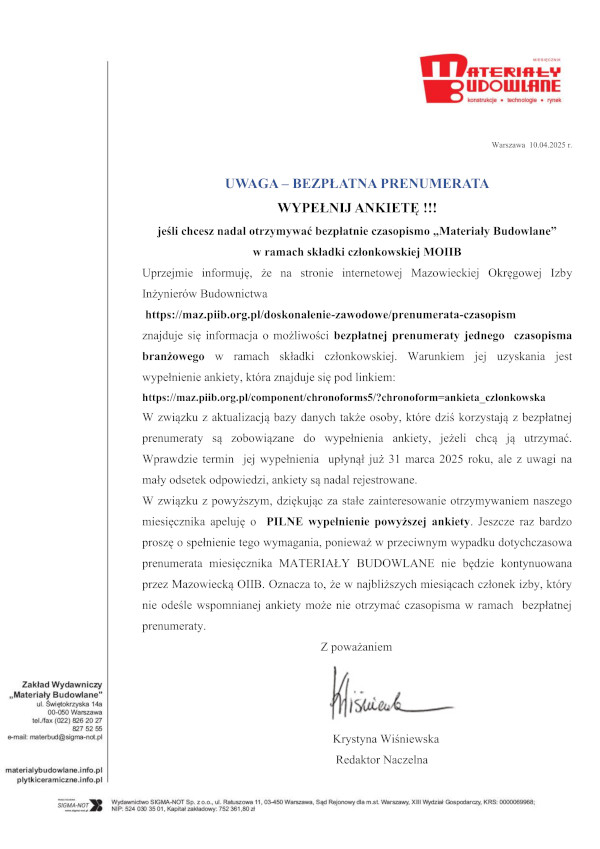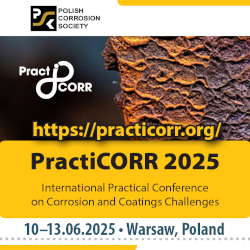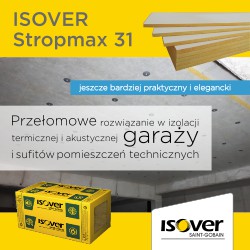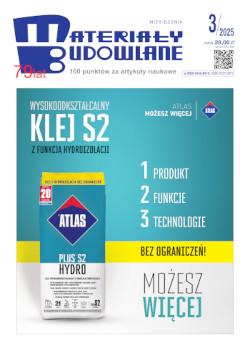Open Access (Artykuł w pliku PDF)
New methods of determining fungi and algae in construction
mgr inż. Michał Komar, Politechnika Łódzka, Interdyscyplinarna Szkoła Doktorska
ORCID: 0000-0001-6354-6885
dr hab. inż. Justyna Szulc, Politechnika Łódzka, Wydział Biotechnologii i Nauk o Żywności
ORCID: 0000-0002-6601-2376
prof. dr hab. Beata Gutarowska, Politechnika Łódzka, Wydział Biotechnologii i Nauk o Żywności
ORCID: 0000-0002-9223-2001
Adres do korespondencji: Ten adres pocztowy jest chroniony przed spamowaniem. Aby go zobaczyć, konieczne jest włączenie w przeglądarce obsługi JavaScript.
DOI: 10.15199/33.2024.05.06
Artykuł przeglądowy
Streszczenie. Mikroorganizmy zasiedlają materiały budowlane od pierwszych dni ich użytkowania. Powodują biodeteriorację i przyczyniają się do strat ekonomicznych, a w przypadku wnętrza budynków mogą negatywnie oddziaływać na zdrowie mieszkańców. Istotne jest wczesne wykrywanie grzybów i glonów na materiałach budowlanych. Poniższy artykuł zawiera przegląd literaturowy metod wykrywania grzybów i glonów na materiałach budowlanych oraz przedstawia nową metodę oceny trwałości powłok przed porastaniem.
Słowa kluczowe: grzyby; glony; analiza mykologiczna; analiza algologiczna; biodeterioracja materiałów budowlanych.
Abstract. Microorganisms inhabit building materials from the first days of their use. They cause biodeterioration and contribute to economic losses, and in the case of building interiors, theymay negatively affect the health of residents. Early detection of fungi and algae on building materials is important. The following article contains a literature review of research methods for detecting fungi and algae on building materials and presents a new method for assessing the resistance of coatings against fouling.
Keywords: fungi; algae; mycological analysis; algological analysis; biodeterioration of building materials.
Literatura
[1] Cutler N,Viles H. Eukaryoticmicroorganisms and stone biodeterioration. Geomicrobiol. J. DOI: 10.1080/01490451003702933.
[2] Allsopp D, Seal KJ, Gaylarde CC. Introduction to Biodeterioration, 2nd ed. Cambridge: Cambridge University Press. 2004; DOI: DOI: 10.1017/CBO9780511617065.
[3] Dergunova A, Piksaykina A, Bogatov A, Salman ADSD, Erofeev V. The economic damage from biodeterioration in building sector. IOP Conf. Ser. Mater. Sci. Eng. 2019; DOI: 10.1088/1757-899X/698/7/077020.
[4] Zyska B. Zagrożenia biologiczne w budynku. Warszawa: Arkady, 1999.
[5] PN-EN 15457:2022-08. Farby i lakiery – Laboratoryjna metoda badania skuteczności w powłoce środków ochrony powłok przed grzybami. 2022.
[6] PN-EN 15458:2022-08. Farby i lakiery – Laboratoryjna metoda badania skuteczności w powłoce środków ochrony powłok przed glonami. 2022.
[7] Wiejak A. Ocena skuteczności działania środków ochrony powłok elewacyjnych przed grzybami pleśniowymi i glonami. Pr. Inst. Tech. Bud. 2011 40: 15 – 2.
[8] Kata I, Stasica Z, Szafran K. Czynniki sprzyjające korozji mikrobiologicznej ocieplonych elewacji i sposoby jej zapobiegania. Materiały Budowlane. 2021; DOI: 10.15199/33.2021.01.02.
[9] Gutarowska B, Piotrowska M, Koziróg A. Grzyby w budynkach, Zagrożenia, ochrona, usuwanie. Wydawnictwo Naukowe PWN, 2019.
[10] Gutarowska B, Piotrowska M. Methods of mycological analysis in buildings. Build. Environ. 2007; DOI: https://doi.org/10.1016/j.buildenv. 2006.02.015.
[11] Lindemann V, Schleiner T, Maier U, Fels H, Cramer B, Humpf H-U. Analysis of mold and mycotoxins in naturally infested indoor building materials. Mycotoxin Res. 2022; DOI: 10.1007/s12550-022-00461-3.
[12] Lewinska A, Peuhkuri R, Rode C, Andersen B, Hoof J. Rapid detection and identification of Stachybotrys and Chaetomium species using tissue PCR analysis. J. Microbiol. Methods. 2016; doi: 10.1016/j.mimet.2016.09.005.
[13] Garbacz M, Malec A, Duda-Saternus S, Suchorab Z, Guz Ł, Łagód G. Methods for Early Detection of Microbiological Infestation of Buildings Based on Gas Sensor Technologies. Chemosensors. 2020; DOI: 10.3390/chemosensors8010007.
[14] Szponar Band, Larsson L. Determination of microbial colonisation in water-damaged buildings using chemical marker analysis by gas chromatography –Mass spectrometry. IndoorAir. 2000; 10: 13 – 18.
[15] Gutarowska B, Żakowska Z. Elaboration and application of mathematical model for estimation of mould contamination of some building materials based on ergosterol content determination. Int. Biodeterior. Biodegradation. 2002, DOI: https://doi.org/10.1016/S0964-8305 (02) 00063-X.
[16] Rozporządzenie Ministra Zdrowia z 11 grudnia 2020 r. zmieniające rozporządzenie w sprawie szkodliwych czynników biologicznych dla zdrowia w środowisku pracy oraz ochrony zdrowia pracowników zawodowo narażonych na te czynniki. Ministerstwo Zdrowia, 2020.
[17] Gutarowska B, Kosmowska M, Wiszniewska M, Palczynski C, Walusiak-Skorupa J. An Investigation of Allergenic Proteins Produced by Moulds on Building Materials. Indoor Built Environ. – INDOOR BUILT Env. 2012; DOI: 10.1177/1420326X11413911.
[18] Uher B. Spatial distribution of cyanobacteria and algae from the tombstone in a historic cemetery in Bratislava. Slovakia-Fottea. 2008; 9: 81 – 92.
[19] Piontek M, Lechów H, Paradowska E, Nycz M. Examination of deteriogenic biofilms on building facades with scanning electronmicroscopy. Civ. Environ. Eng. Reports. 2016; 20 (1): 79 –88.
[20] Czerwik-Marcinkowska J, Mrozińska T. Algae and cyanobacteria in caves of the Polish Jura. Polish Bot. J. 2011; 56(2): 203 – 243.
[21] Rindi F. Diversity, Distribution and Ecology of GreenAlgae and Cyanobacteria in Urban Habitats. 2006; DOI: 10.1007/978-1-4020-6112-7_34.
[22] Rindi F, Guiry MD. Composition and spatial variability of terrestrial algal assemblages occurring at the bases of urban walls in Europe. Phycologia. 2004; DOI: 10.2216/i0031-8884-43-3-225.1.
[23] Cheung SL, Allen DG, Short SM. Specific quantification of Scenedesmus obliquus and Chlorella vulgaris in mixed-species algal biofilms. Bioresour. Technol. 2020; DOI: https://doi. org/10.1016/j.biortech. 2019.122251.
[24] Hallmann C, Rüdrich J, Enseleit M, Friedl T, Hoppert M. Microbial diversity on a marble monument: A case study. Environ. Earth Sci. 2010; DOI: 10.1007/s12665-010-0772-3.
[25] Starmach K. Plankton roślinny wód słodkich. Warszawa: Państwowe Wydawnictwo Naukowe, 1989.
[26] Tang Y et al. Hybrid Xerogel Films as Novel Coatings for Antifouling and Fouling Release. Biofouling. 2005;DOI: 10.1080/08927010500070935.
[27] Chaudhury M, Finlay J, Chung J, Callow M, Callow J. The influence of elastic modulus and thickness on the release of the soft-fouling green alga Ulva linza (syn. Enteromorpha linza) from poly (dimethylsiloxane) (PDMS) model networks. Biofouling. 2005; DOI: 10.1080/08927010500044377.
[28] Prieto B, Silva B, Lantes O. Biofilm quantification on stone surfaces: Comparison of various methods. Sci. Total Environ. 2004; DOI: 10.1016/j. scitotenv. 2004.05.003.
[29] Komar M, Szulc J, Kata I, Szafran K, Gutarowska B. Development of a Method for Assessing the Resistance of Building Coatings to Phoatoautotrophic Biofouling. Applied Sciences. 2023. DOI: 10.3390/app13148009.
[30] EggertA, Häubner N, Klausch S, Karsten U, Schumann R. Quantification of algal biofilms colonising building materials: Chlorophyll α measured by PAM-fluorometry as a biomass parameter. Biofouling. 2006, DOI: 10.1080/08927010600579090.
[31] Giakoumaki A, Philippidis A, Siozos P, Pyrri I, Anglos D, Pouli P. Development of a methodology for the characterisation and assessment of biodeteriogens on archaeological surfaces by use of a portable LED-induced fluorescence instrument. Herit. Sci. 2022; DOI: 10.1186/s40494- -022-00827-x.
[32] Nakajima M, Hokoi S, Ogura D, Iba C. Field survey of the relationship between environmental conditions and algal growth on exterior walls. Build. Environ. 2020, DOI: https://doi. org/10.1016/j. buildenv. 2019.106575.
[33] Kukletová I, Chromková I. Testing of algae colonization growth risk on building materials. IOP Conf. Ser. Mater. Sci. Eng. 2018; DOI: 10.1088/1757-899X/379/1/012041.
[34] Bloomfield NJ, Wei S, Woodham BA, Wilkinson P, Robinson AP. Automating the assessment of biofouling in images using expert agreement as a gold standard. Sci. Rep. 2021; DOI: 10.1038/s41598-021-81011-2.
[35] Szulc J, Komar M, Kata I, Szafran K, Gutarowska B. Novel Method for Assessing the Protection Lifetime of Building Coatings against Fungi. Coatings, vol. 13, no. 12. 2023. DOI: 10.3390/coatings13122026.
[36] Gutarowska B, Szulc J, Komar M. Sposób laboratoryjny oceny czasu trwałości zabezpieczenia przeciwgrzybowego i przeciwglonowego tynków budów. P. 444942, 2023.
[37] European Organization for TechnicalAssessment (EOTA. External Thermal Insulation Composite Systems (Etics) With Renderings – EAD 040083-00-0404. 2020.
[38] Schneider CA, Rasband WS, Eliceiri KW. NIH Image to ImageJ: 25 years of image analysis. Nat. Methods. 2012; DOI: 10.1038/nmeth.2089.
Przyjęto do druku: 02.05.2024 r.
Materiały Budowlane 5/2024, strona 26-30 (spis treści >>)































